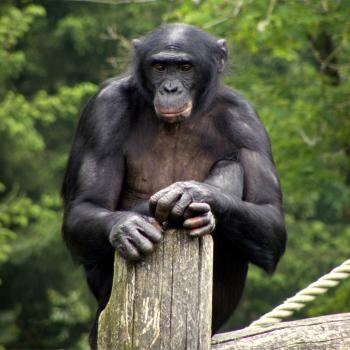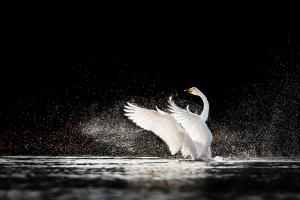
Naturalists of the ancient world once believed the whooper swan was the original ancestor of all birds. It was the first avian species to receive a Latin name, Cygnus. In Siberia and northern Japan, shamanic cultures identified the whooper as their ancestral mother.
Whoopers were also believed to be an all-female species that propagated by immaculate conception. In parts of northern Russia the birth of the Virgin Mary is celebrated on September 21 by releasing two swans. The bright white swan has long been a symbol of purity.
It’s fair to say the whooper swan was once the virgin queen of the bird kingdom, a lofty position that can be traced back to the nurturing behavior displayed by both females and males as described in The Whooper Swan (2003, T & A D Poyser), a monograph by ornithologist Mark Brazil.
The whooper is the only swan species that shares all parental duties between males and females, including gathering food, feeding the young, maintaining the nest, practicing vigilance and teaching cygnets to fly. The whooper is exceedingly affectionate with its offspring and is the only swan species known to adopt and raise orphaned cygnets.
Overall Brazil concluded that whoopers are the most vocal and intelligent of all swan species, with pairs mating over a lifespan of about 15 years and raising an average of 40 swans. An impressive 85 percent of cygnets make it to adulthood.
Studying the virgin queen
The sacredness of the swan across ancient cultures meant Brazil was not the first to closely observe the large and graceful bird, which lives in river and delta habitats often shared with humans.
If the whooper was so deeply respected for its divine qualities it would have been studied up close – druid priests were said to wear a swan-feather cloak with a swan’s neck and head tossed over the back, perhaps reflecting gained wisdom.
If naturalists once studied the whooper it’s not hard to see how its unique parenting behavior was woven into a mythic portrait of a nurturing, all-female species, the ancestral mother. And there’s even an offbeat piece of circumstantial evidence to support the whooper’s alleged virginity.
As of 2003, Brazil was the only ornithologist on record to observe whooper swans in the act of coitus, and only twice in years of fieldwork. The rare and partially-submerged event he described involves a sideways approach to the female that doesn’t necessarily appear to be a sexual act. In contrast, most other large animals make it fairly obvious when mating season rolls around. Thus the virgin queen.
The swan-maiden myth
With a wingspan of more than nine feet and weighing up to thirty pounds, whooper swans are hard to miss and myths about the majestic bird are found across its summer and winter habitat, from Iceland to the Mediterranean and the Near East, China, Siberia and northern Japan.
Brazil observed that whooper parents somehow stagger the timing of their six-week summer molting periods so that one parent is always capable of flight. When extraordinary and unexplained behaviors like this occur, scholars place them in the catch-all category of “biological imperative.”
Meanwhile the self-regenerative process of losing and growing back feathers may have inspired a cross-cultural myth in which a man traps a swan-maiden by stealing her cloak of feathers while she bathes in a pond.
The man and the swan-maiden often marry and sometimes have children but the swan-maiden always regains her cloak and flies away at the end. The widespread myth may also reflect the ancient domestication of swans, a job made easier when molting birds were unable to fly.
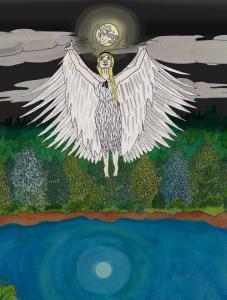
The musical whooper
Brazil describes whoopers seeming to ‘talk’ in short, high-pitched conversational tones and making harmonious monosyllabic calls while swimming. The flock is quieter at night but still vocalizes in soft trills and twitters.
Perhaps the whooper’s most incredible vocal display occurs when two birds meet after spending time apart. The greeting begins with an extended duet that morphs into both swans singing the same song in perfect synchrony. When the music ends, the pair flap their wings and rush together.
This common greeting was doubtless considered meaningful by observers, including the ancient Irish. It was the habit of a certain pagan king to sing half a quatrain to his queen each night, followed by the queen singing the other half back to him, according to Myles Dillon’s Early Irish Literature (1948, University of Chicago Press).
Admiration for the whooper’s musical abilities is reflected in an Irish legend from an 8th century text about a man named Aengus falling in love with a woman who shape-shifted into a whooper swan on a regular basis.
When Aengus went searching for his love one day he found her in the form of a swan and transformed himself into a male swan so they could be together. The pair flew off connected by a slender golden chain around their necks, singing with joy. When they arrived back at Aengus’ home in the Boyne Valley, the pair sang so beautifully that listeners fell into a deep and soothing sleep.
Whooper swans sang along with a human chorus conducted by the sun god Apollo on a mythical island in the “far north,” according to Greek historian Diodorus Siculus.
“… the swans made their concordant music, not losing time or tune … and were joining their natural music with that of the artists of the sacred minstrelsy; and then, when the hymn ends, away they fly…”
In a play by the Greek Euripides, the lyre of Apollo is tuned to the song of the swan. In Greek artwork swans were shown singing while men played the lyre. A medieval French bestiary praised the ability of swans to harmonize with the harp.
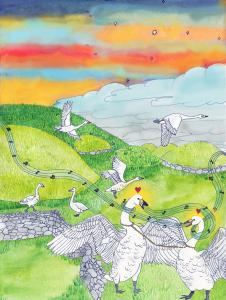
The fall festival of birds
If ancient cultures observed and imitated whooper swans, they may also have adopted another remarkable avian behavior pattern: the week-long autumn gathering, complete with feasting, music and yes, dancing.
Brazil observed that during summer and fall the non-breeding (single adult) whoopers flew off to enjoy mountain springs while families stayed in coves along the shore. But in late fall the entire flock reunited and settled down for a week or more of feasting on algae and mollusks before heading south for the winter.
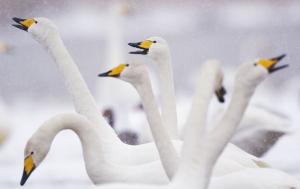
To improve their chances, Brazil noted that whoopers tend to take off under clear skies and a full moon. He also observed that non-breeding whoopers took off first in the fall, presumably to clear the winter grounds of any interlopers before the families arrived. In spring the breeders take off first, presumably to get busy making eggs.
However, whooper swans weigh up to 30 pounds and the simple act of taking off is no easy feat, especially after loading up on algae and oysters. To ensure a successful take-off it appears the forces of natural selection settled on a remarkable strategy.
On a clear night under a near-full moon Brazil observed the entire flock begin to vocalize and move about. Soon a song-and-dance routine broke out that steadily accelerated in pace and volume, faster and faster, louder and louder until the frenzied birds started running full tilt with their huge webbed feet smacking the water until finally gaining altitude with their nine-foot wingspan. Brazil suggested the frenzied calling and dancing was the whoopers’ way of getting psyched up for the take-off.
Flight of the soul
British archaeologist Aubrey Burl wrote of Neolithic-era people in the British Isles traveling up to a hundred miles for a massive feast held in late autumn inside stone rings that ranged up to twenty-four acres in size, accommodating well over a thousand people.
Burl cited the remains of hazelnuts, crab-apples and calves at various archaeological sites to suggest a late autumn date for the gatherings, coinciding with the mass departure of migratory birds.
Cross-cultural evidence shows that people across ancient cultures once believed migratory birds carried the souls of the year’s dead to an unknown land and guided them through the afterlife. The gatherings described by Burl may have been communal funerals to release the souls of the dead so swans could fly them somewhere beyond the horizon.
Milky Way migration
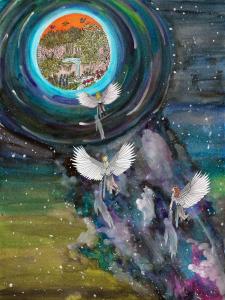
Perhaps the most literal description of the soul’s afterlife journey is found in the Finnish epic Kalevela, which describes swans flying souls of the dead to a warm place beyond the horizon, and then up the Milky Way to the northern celestial pole.
As the soul-bearing swans approach the pole, a swirling wind caused by the turning bowl of stars pulls them out through a small hole to a heavenly land of rest called Tuonela. Ultimately the swans complete their round-trip migration and return rejuvenated ‘new’ souls to pregnant mothers on Earth.
The Finns’ notion of soul migration may stem from their observation of whooper swans migrating in late fall, heading southeast from Finland toward a point where the horizon meets the Milky Way.
In the imagination of those who forged the myth, the swans flew beyond the horizon of the material world and into the spirit world of the Milky Way, where the constellation Cygnus could be seen flying north towards the celestial pole.
Over the winter, Cygnus appears to fly up and around the apparent hub of the universe as if tending a nest. As spring arrives, Cygnus appears to dive toward earth again, as one wing brushes the horizon. Imagining a similar journey, early Icelanders believed the whooper was a supernatural being that made an annual journey to its ancestral home in Valhalla.
Flying high
Brazil wrote that while whoopers typically migrate at a reasonable altitude of several thousand feet, sometimes they catch a ride on the much higher jet stream. A pilot flying over the Inner Hebrides one day was startled to observe a group of whoopers at 24,600 feet. Using radar he clocked them flying at 86 miles per hour.
(Ben H. Gagnon is the author of Church of Birds: An Eco-History of Myth and Religion, coming from John Hunt Publishing, London, in March 2023, and now available for pre-order. More information, including endorsements, can be found at churchofbirds.godaddysites.com. A link to the YouTube video covering major themes of the book is here.)










